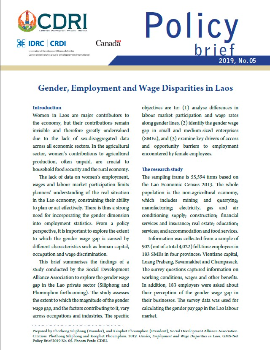
Irrigation Water Productivity in Cambodian Rice Systems
Keyword: Rice production, irrigation efficiency, water resource management, agricultural productivity, policy implications
Abstract/Summary
Cambodia’s economy is based largely on the agricultural sector
which contributes 33 percent of the national GDP and employs more than 67
percent of the national labour force. Rice production is central to this
sector: not only do the majority of Cambodia’s farmers depend directly and
indirectly on the success of the rice crop each year, but being the main food
staple, rice production is a significant factor in the national effort to
promote food security. Despite its importance, rice farming in Cambodia has
traditionally been dependent on rainfall rather than irrigation. Rainfall
distribution determines the success and size of the harvest and, as a result, farmers
generally only grow only one crop per year.
Recognising the importance of water management to promoting the
country’s rice production, the Royal Government of Cambodia and donors are
making efforts to expand the irrigated area in Cambodia. The expectation is
that irrigation will make farmers less reliant on rainfall, allowing them to
cultivate more crops with more certainty and predictability, resulting in
higher productivity and better livelihood outcomes. The government’s current
planning document emphasises the importance of water management to increase
agricultural productivity and stresses ‘rehabilitating and enhancing irrigation
potential’ (RGC 2009:28).
However, despite the importance given to irrigation in Cambodia’s
development strategies, there is lack of quantitative information regarding the
value of water at the farm level. This paper presents key findings from the
economic component of the Water Resources Management Research Capacity
Development Programme (WRMRCDP) to address this question and discusses some of
the policy implications of these findings, particularly in regard to the
definition of irrigation fees.
The key findings of this paper are that estimates of the extra
yield produced as a result of irrigation, when measured in terms of rice
production, are very low. This is particularly the case in the wet season: an
increase of 1 percent in the amount of water used leads to an increase in rice
yield of only 0.06 percent in the wet season and 0.12 percent in the dry
season. For amounts of water larger than 1000 cubic metres per plot, and
controlling for other inputs (including land), very little is added to yield
size.
The overall key policy implications are that:
- The marginal return from water use to farmers in the wet season is low; therefore, farmers will not be willing to pay much for water during the wet season;
- This lack of willingness to pay for water limits the feasibility of cost-recovery policies as well as decisions on infrastructure investment and maintenance;
- Increasing productivity in the wet season is central to any effort to better manage irrigation water.



